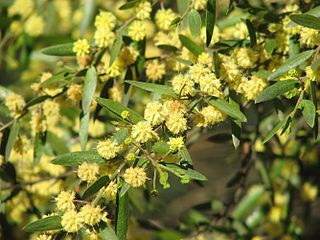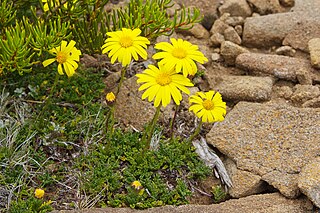
Epacris impressa, also known as common heath, is a plant of the heath family, Ericaceae, that is native to southeast Australia. French botanist Jacques Labillardière collected the species in 1793 and described it in 1805. Four forms have been identified, but no subspecies are recognised. Growing in heathland, shrubland or open forest, it is generally a small shrub around 0.5 to 1 m tall, with small stiff leaves. The red, pink or white tube-like flowers appear from late autumn to early spring. Honeyeater birds, particularly the eastern spinebill, feed upon the nectar of the flowers. It regenerates after bushfire by seed or by resprouting.

Sir William Jackson Hooker was an English systematic botanist and organiser, and botanical illustrator. He held the post of Regius Professor of Botany at Glasgow University, and was Director of the Royal Botanic Gardens, Kew. He enjoyed the friendship and support of Sir Joseph Banks for his exploring, collecting and organising work. His son, Joseph Dalton Hooker, succeeded him to the Directorship of Kew Gardens.
Index Fungorum is an international project to index all formal names in the Fungus Kingdom. As of 2015 the project is based at the Royal Botanic Gardens, Kew, one of three partners along with Landcare Research and the Institute of Microbiology, Chinese Academy of Sciences.

Eucalyptus crebra, commonly known as the narrow-leaved ironbark or narrowleaf red ironbark, is a type of Ironbark tree native to eastern Australia. A member of the large genus Eucalyptus, this tree is in the Myrtaceae family and can grow to a large spreading tree up to 35 m (115 ft) high. It is an important source of nectar in the honey industry and its hard, strong timber is used in construction.
The World Geographical Scheme for Recording Plant Distributions (WGSRPD) is a biogeographical system developed by the international Biodiversity Information Standards (TDWG) organization, formerly the International Working Group on Taxonomic Databases. The WGSRPD standards, like other standards for data fields in botanical databases, were developed to promote "the wider and more effective dissemination of information about the world's heritage of biological organisms for the benefit of the world at large". The system provides clear definitions and codes for recording plant distributions at four scales or levels, from "botanical continents" down to parts of large countries. Current users of the system include the International Union for Conservation of Nature (IUCN), the Germplasm Resources Information Network (GRIN), and the World Checklist of Selected Plant Families (WCSP).

Botanical illustration is the art of depicting the form, color, and details of plant species, frequently in watercolor paintings. They must be scientifically accurate but often also have an artistic component and may be printed with a botanical description in books, magazines, and other media or sold as a work of art. Often composed in consultation with a scientific author, their creation requires an understanding of plant morphology and access to specimens and references.

The National Herbarium of Victoria is one of Australia's earliest herbaria, and the oldest scientific institution in Victoria. It was established in 1853 by Ferdinand von Mueller, the Government Botanist for Victoria, and is situated within the Royal Botanic Gardens, Melbourne. The present building was constructed in 1934 through a donation from philanthropist Sir Macpherson Robertson. It, along with a 1989 extension, houses the entire collection of 1.5 million plant and fungal specimens. The Herbarium's botanic library is an important source for the history of Australian botany, and has contributed some 124 volumes to the online digital Biodiversity Heritage Library.

Thysanotus patersonii, the twining fringe-lily, is a climbing perennial herb which is endemic to Australia.
Crassula colorata, the dense pigmyweed or dense stonecrop, is an annual plant in the family Crassulaceae. The species is endemic to Australia, occurring in Western Australia, South Australia, New South Wales and Victoria.

Hakea ulicina, commonly known as furze hakea, is a shrub in the family Proteaceae, native to Australia.

Kennedia prostrata, commonly known as running postman or scarlet runner or scarlet coral pea, is a species of flowering plant in the family Fabaceae, endemic to Australia.

Kennedia rubicunda, commonly known as the dusky coral pea, is a species of flowering plant in the family Fabaceae, endemic to Australia. It occurs in the states of Victoria and New South Wales and Queensland.
Flora of China is a scientific publication aimed at describing the plants native to China.

Kew Gardens is a botanical garden in southwest London that houses the "largest and most diverse botanical and mycological collections in the world". Founded in 1840, from the exotic garden at Kew Park in Middlesex, England, its living collections include more than 30,000 different kinds of plants, while the herbarium, which is one of the largest in the world, has over seven million preserved plant specimens. The library contains more than 750,000 volumes, and the illustrations collection contains more than 175,000 prints and drawings of plants. It is one of London's top tourist attractions and is a World Heritage Site.

Acacia verniciflua, commonly known as varnish wattle, is a shrub or small tree species that is endemic to Australia. It has an erect or spreading habit, growing to between 1 and 6 metres high, The phyllodes are often sticky and lustrous and vary in length, width and shape. The globular pale-yellow flowerheads appear in the leaf axils from July to November, followed by seedpods that are up to 10 cm long and unconstricted. These contain shiny black seeds. It is often found growing alongside Eucalyptus obliqua where it can dominate the understory.

Persoonia rigida, commonly known as the rigid-, hairy- or stiff geebung, is a shrub native to New South Wales and Victoria in eastern Australia. First collected by George Caley in 1804, it was one of the many Australian plants first described by Scottish botanist Robert Brown, and still bears the binomial name he gave it in 1830. Within the genus Persoonia, P. rigida is classified in the lanceolata group, a group of 54 closely related species with similar flowers but very different foliage. These species will often interbreed with each other where two members of the group occur. It grows as a small shrub to 1 m (3.3 ft) high, and has hairy new branches and leaves. The narrow leaves measure 1.5 to 4.5 cm long, and 0.4–1.9 cm wide and are spathulate or obovate in shape, with margins turning downwards. Appearing in summer, the inflorescences are composed of single yellow flowers and have hairy perianths. The proportion of flowers going on to develop fruit appears to be unusually high in P. rigida compared with other members of the genus.

Senecio pectinatus, commonly known as alpine groundsel, is a species of flowering plant in the aster family. The species occurs in alpine areas of south-eastern Australia in peat-based soils. It has divided leaves forming a basal rosette and produces a single yellow flower head on a stalk up to 20 cm high.

Coprosma hirtella is a shrub in the family Rubiaceae. It is endemic to south-eastern Australia. It grows to about 2 metres high and has leaves that are between 15 and 50 mm long and 10 to 25 mm wide. Plants have male and female flower clusters that appear between August and April. These are followed by orange to reddish fruits that are 7 to 8 mm in diameter.
















